2011 Dodge Durango Crew AWD vs. 2011 Ford Explorer XLT 4WD, 2011 Honda Pilot Touring 4WD
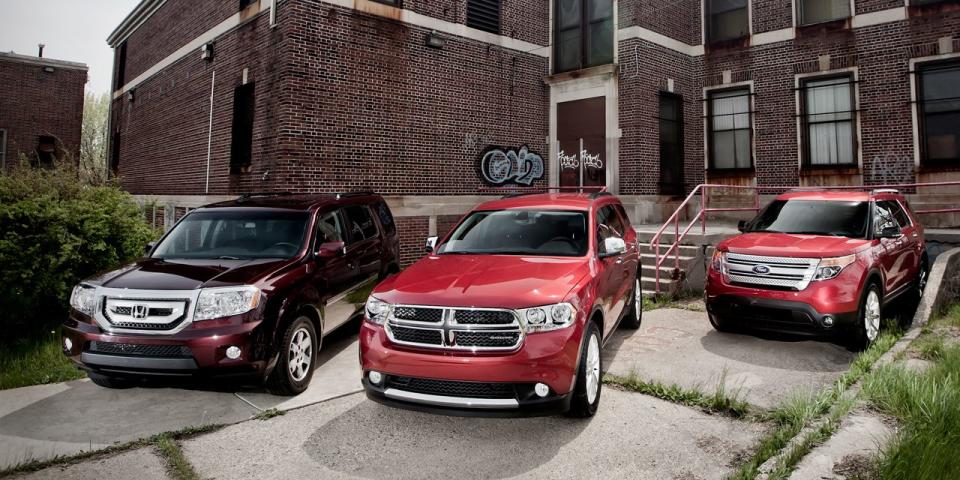
From the September 2011 Issue of Car and Driver

When it comes to automotive function, it’s hard to beat the minivan. But, aside from a fussy two-year old, few things shout “Mommy!” quite as loudly. Minivans are about parenting, and moms and dads—as any teenager can attest—aren’t cool.
And yet, some parents cling desperately to the fantasy that they are as hip as Miles Davis. They might need a minivan, but they just can’t stand the silent judgments of society. Enter the alternative to the one-box kid hauler: the three-row SUV. We last visited this burgeoning segment in 2008, when we assembled six three-row non-minivans. The Honda Pilot emerged victorious by a slight margin over the Mazda CX-9. We praised the Pilot’s spacious eight-passenger interior, its eagerness to venture off-road, and its somewhat carlike handling. Since then, two all-new competitors have turned up in the car-pool lane.
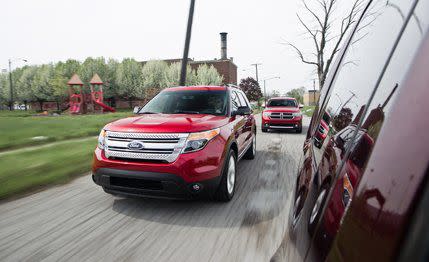
From Ford comes the Explorer. Once a sales-topping SUV and the darling of suburbia (until it became branded a rolling, flipping, tire-tread-shedding menace), the Explorer is new from the rubber up. The traditional body-on-frame structure is gone, swapped for a slightly lighter unibody platform that also underpins the Flex and whose roots can be traced to Volvo. A V-8 is absent from the order books; the most powerful engine is a 290-hp, 3.5-liter V-6. For the fuel conscious, a turbocharged 2.0-liter four-cylinder with 237 horsepower is on its way. All-wheel drive is an option on V-6 models; otherwise, the Explorer is a front-drive machine.
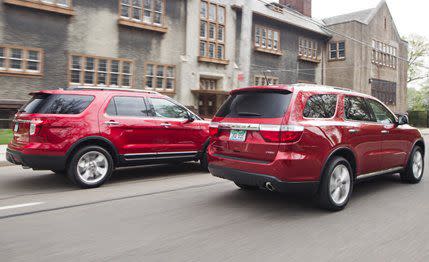
Over at Dodge, the old-school body-on-frame Durango sat out Chrysler’s bankruptcy ugliness and, like the Explorer, has returned this year as a unibody “crossover” SUV. A product of parent company Chrysler’s now severed ties with Mercedes-Benz, the platform can count the Benz ML and the new Jeep Grand Cherokee as kin. Unlike its three-row competition gathered here, the Durango can still be had with a V-8—a very serious 360-hp, 5.7-liter Hemi. But this class is dominated by V-6 power, so for this test we recruited a Durango with the standard 290-hp, 3.6-liter V-6 (there’s also a Heat trim level, which increases V-6 power to 295). Unlike the Explorer, two-wheel-drive Durangos are rear-drive.
In the interest of determining which minivan alternative works best, we spent a few days and more than 300 miles driving these three vehicles, climbing in and out of second and third rows, and folding and unfolding seats. During our drive, we stopped for lunch at Win Schuler’s restaurant in Marshall, Michigan, where the spreadable and highly addictive Bar Scheeze was created. We brought back a large tub of the zesty cheese for our co-workers to enjoy, plus a new champ in the three-row-SUV class.

The first line of the first page of the Honda’s logbook reads, “Much noisier than I remember.” We’ve had a lot of Pilot experience, including a 40,000-mile long-term test, but we could not recall any of those Pilots exhibiting as much wind, tire, and engine thrum as this one. The aural assault didn’t show up on the sound-level meter, where the Honda scored 71 decibels, same as the Dodge and the Ford. But on the road, any pavement break or imperfection generates a slapping whack from the tires. On the highway, the engine protests as the transmission shifts between fifth and fourth gears in an attempt to force the refrigerator-shaped Pilot through the air. The atmosphere objects to the abuse and makes its discontent known as wind noise around the Pilot’s upright A-pillars.
Aside from a surprising skidpad figure of 0.81 g and controllable handling at the limit, we didn’t find much about the Pilot’s dynamics to compliment. A soft and underdamped suspension gives the truck a cumbersome mien that says, “Don’t rush me. I’m really just a minivan with off-road pretensions.” The body rocks back and forth under braking and acceleration. Whereas the Durango and Explorer cruise down the road, the Pilot seems to lumber.
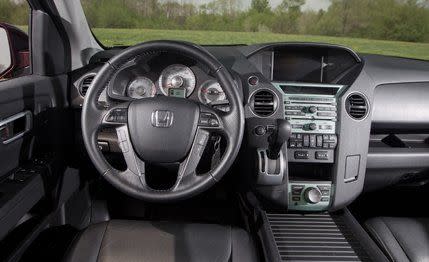
“Lacks refinement and really shows its age when driven back-to-back with the new competition,” wrote technical editor K.C. Colwell. But the Honda can still claim a few wins. Supportive seats that adjust to a comfortable position face an upright dashboard and windshield. Huge panes of glass and relatively small roof pillars make the Pilot easy to park and place on the road. While the Dodge and the Ford attempt to mimic sports-car interiors, the Pilot makes no such effort. Like a minivan, the Pilot trades in space rather than style.
Despite being the shortest of the trio by 6.2 inches, the Honda boasts nearly moving-van levels of interior volume. The Pilot has the most passenger room in each of its three rows and scored highest for comfort. And its low floor and tall roof are able to swallow the most beer cases, ensuring comfort once you reach your destination.
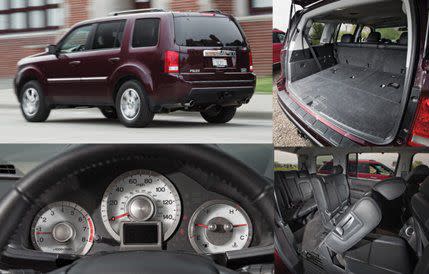
Unlike the Explorer and the Durango, the Pilot’s second-row bench slides fore and aft to provide more legroom for the third row, at the expense of second-row occupants’ knees. Of the three SUVs, two adults would be happiest in the Pilot’s third row. Unlike the Ford and the Dodge, which sport only two belts, the Honda has three. A trio of adults wedged back there would find the experience highly unpleasant, though, and getting there is a challenge due to a second row that only slides—the middle seats of the Dodge and the Ford both fold and flip forward, providing wider access.
Still, the Pilot proved to be the minivan of this group. If your priority is interior space but you can’t bring yourself to drive something with sliding doors, then the Pilot will not embarrass you at kid-pickup time. For a superior-driving SUV, read on.
Don’t think for a moment that Ford is arriving late to this segment. Way back in 2004—years before the Flex—Ford had a three-row unibody “crossover” SUV. Not ringing a bell? Well, that’s probably Ford’s fault. The company called it the Freestyle for a few years and then, possibly to confuse buyers, changed its name to Taurus X. In addition to no one being able to recall its handle, it looked like a station wagon.With the new Explorer, Ford seems committed to correcting those mistakes. Its new entry in the segment wears the Explorer name, a badge that has as much resonance within the company as Thunderbird, Mustang, and Model T. And while its looks may not be as shocking as those of the Bauhausian Flex, the Explorer is a tastefully styled, modern SUV. This means it looks more like a running shoe than a station wagon.
Huge front doors open to a vast interior with 56 cubic feet of front-seat space. Adding to the sense of volume is a dashboard that sweeps away from the driver’s seat. “The Explorer’s interior makes me feel like I’m five feet tall,” wrote six-foot-tall associate online editor Jon Yanca. Within arm’s reach, in the center of the instrument panel, is the MyFord Touch infotainment unit. The system is often slow to respond or recognize inputs. Late in our evaluation, the touch screen froze. Disconnecting and reconnecting the car’s battery rebooted the system, at which point the screen displayed a Microsoft logo and the words, “Performing Scheduled Maintenance.”
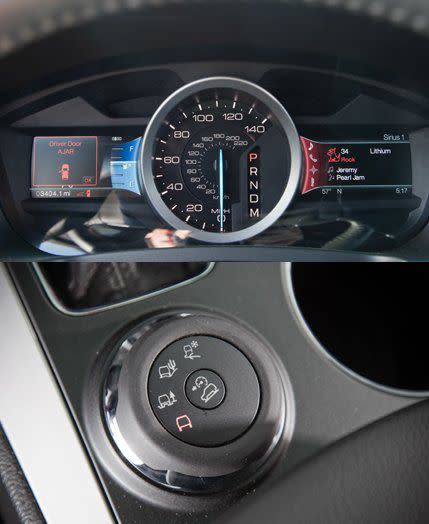
At odds with the rolling-gymnasium feel of the Explorer is a small-diameter, thin-rimmed steering wheel with low effort. It seems to have been selected to mask the vehicle’s 197.1-inch length and 4747-pound curb weight. Despite the unbearable lightness of steering, chosen vectors become deliberate and secure, without the clumsiness of the Pilot. The nose-heavy Explorer feels substantial, never playful, but it did surprise us by nearly matching the more balanced Durango’s speed through the slalom.
Indeed, haste comes easier in the Ford than in the Honda or the Dodge. Ford’s V-6 offers more torque at fewer revolutions than its rivals’ engines, and the six-speed automatic is one gear up on the competition. Run the V-6 to the 6500-rpm redline, and it sounds less strained than the sixes in the Pilot and the Durango. The suspension tuning is stiff and the structure even stiffer. There were some complaints about a mushy brake pedal, but a 177-foot stop from 70 mph would have made it the braking king in our most-recent comparison test of this class.

The 78.9-inch-wide Explorer’s second row (down one cubic foot to the Pilot’s volume) is broad in the beam, but the seating position is low relative to the windows. The Honda’s fore-aft adjustment is absent, but climbing into the third row is made easy by long rear doors and the second-row’s ability to fold and flip forward. As long as the second row isn’t reclined too far, the two-seat third row has decent legroom, and the seat itself is well contoured. Folding the third row in the Explorer is more complicated than in the Dodge or the Honda: Pull the red strap, and the third-row backrest flops forward; pull the black strap, and the entire seat pivots backward into a hidey-hole—very minivanish.
In the end, although the Ford posted the quickest acceleration numbers, it still felt more like a minivan than the winner did—nose heavy, yawn inducing, and strangely redolent of Cheerios. And, after all, aren’t reminders of minivanness the very things these buyers are trying to avoid?
Look briefly at the Durango’s résumé, and this SUV might come across as a loser. It’s the heaviest and longest of the bunch; acceleration lagged behind the others’; and it couldn’t circle the skidpad as quickly as the Ford or the Honda. But the Durango nailed its interview. It starts with the driver’s relationship to the controls and the ease with which the Durango drives down the road. Underneath, the Dodge feels quieter, more solid, and consequently more refined than its rivals. Suspension tuning is stiff, but there isn’t any harshness or chatter from below. Turning the glove-soft leather steering wheel produces immediate results, as the Durango’s 49.5/50.5 front-to-rear weight distribution allows it to precisely follow orders. Think three-row Dodge Charger, not chopped Dodge Grand Caravan.
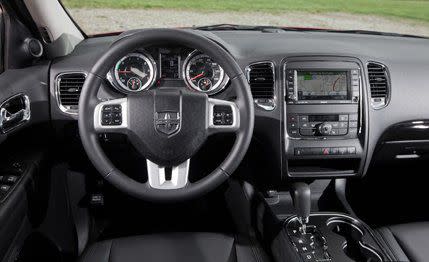
Passenger-volume measurements come up short of Ford’s and Honda’s figures but only by a few cubic feet. The second row lacks the wide feel of the Explorer and the airiness of the Pilot, but the seat offers firm support. Gaining access to the third row is easiest in the Durango: The 119.8-inch wheelbase allows for a large rear doorway, and the second row folds and flops forward with hydraulic assistance, leaving a linebacker-sized opening to the third row. Two narrow, hard seats await third-row riders, but they sit higher than the occupants in the second row, which helps counteract claustrophobia. With the second and third rows folded, the Dodge bested the Explorer’s cargo-hauling numbers, falling just short of the Honda’s.
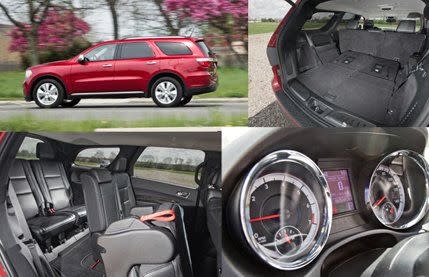
It’s a good thing Dodge offers a more powerful option than the standard 3.6-liter V-6. Dodge’s new engine lacks low-end grunt, which makes taking off from a stoplight a leisurely affair. With the most weight to move around, the Dodge would benefit from more torque or a shorter first gear. Both the Pilot and the Explorer have shorter launch gearing, giving them more energetic acceleration from a stop. Mostly because it had to work harder than the other V-6s, the Durango provided 19 mpg, 1 mpg less than the others. The Durango does have the largest fuel tank (24.6 gallons), allowing it to go nearly 500 miles between fill-ups.
In the final analysis, though, the big Dodge could not have won this comparison test based solely on its chassis scores. It nearly matched Ford’s and Honda’s passenger-carrying ability while offering the best interior materials, an easy-to-use radio and nav-system touch screen, intuitive controls, and elegant interior and exterior designs. The Dodge feels like the most-expensive vehicle here; it feels like the better value; and it feels nothing like a minivan, which consequently makes it feel like a winner. It’s cooler than cool.
You Might Also Like

 Yahoo Autos
Yahoo Autos 